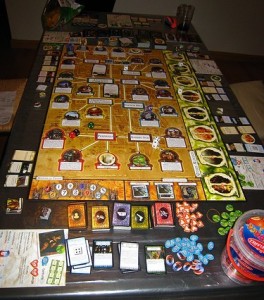You find yourself wandering the quiet streets after a raucous evening with friends, heading home before you have another unfortunate run-in with ol’ Deputy Dingy and his iron bucket. You made some new acquaintances, and everyone was having a swell time.
Well, mostly. There was that one fellow – the one jabbering to himself by the fireplace. He seemed cordial enough when approached, but something about him gave you the heebie-jeebies. He just stared into the flames, muttering something about sightings of…things…out on the edge of town – your edge of town as a matter of fact. Surely he’d tipped a few, but you can’t remember him holding a glass the entire evening…
The air grows colder you abruptly find, and you quicken your pace to match, suddenly hoping you don’t have to find out whether or not he was off his rocker…
The Premise
Strange things are happening in Arkham, Massachusetts, circa 1926. The players are investigators who have banded together to solve a series of mysterious events. In their travels they gather clues, fight monsters, and, ultimately, determine the nature of the doom that has settled upon the town. An Old One – an alien being from beyond the stars – is bent on either subjugating Earth, starting with Arkham. It’s the players’ job to prevent the beast from reaching our realm or, barring that, to use all their moxie to defeat it in combat.
The Rules:
Arkham Horror is a quintessential “Big Box” game: there are over 650 cards, tokens, pieces, player sheets, and dice. Needless to say, setup takes time. It also requires a large playing area. While many of the pieces are not initially used (and some possibly not at all depending on your game session), the set up remains the same. Which components you will need to set up the game will depend on the number of players, which characters players receive, which Old One you’re dealing with, and so on. It’ll be easiest to just say: consult the official rule book for more information.
Players are a team, though each investigator has their own unique set of starting stats, items, and skills. Players will work collaboratively throughout the various game rounds, and round structure is straight-forward:
First, all players have an upkeep step to refresh items and abilities. This will be things like receiving income, reloading your heavy weaponry, or readying your spells. Then they move about the town, often fighting monsters lurking in the streets and sky.
Afterwards, each player has an Encounter (a thematic event affecting them). Encounter cards are specific to a player’s location – so you wouldn’t draw the Asylum card if you were in the Train Station – and they depict the parts of the story affecting each player’s characters throughout the game.
Finally, a Mythos card is drawn. The Mythos cards serve two purposes: as a thematic advancement of the overall story and as the mechanism depicting the Old One’s progress.

“What did you find out Daniel?”
“That we better run Joseph.”
Additionally, Mythos cards spawn various portal locations (gateways to otherworldly locations) and monsters to face. By accumulating the right resources and exploring the rifts, you can attempt to seal portals. If enough portals are sealed, the heroes will successfully thwart the Old One’s attempts, and the players win. However, should too many portals open (or any other number of truly horrible events unfold), the Old One arrives, and players must face It directly. If they are brave, cunning, and lucky enough to defeat it, they have one last chance to snatch victory (and life) from its writhing tentacles and gaping maw.
Otherwise, darkness comes to us all.
The Story Continues
Arkham Horror doesn’t just encompass Lovecraftian flavor – it builds on it. If it were just a rich and fulfilling game experience wrought with new challenges, setbacks, and team dynamics every single time you set it up, you’d already have a successful game. Arkham wraps all of that together, batters it with Cultist Flakes, and deep-fries it in Cthulhu oil.
For fans of the literary genre that bore the game, you will not be disappointed. The original 1987 version of Arkham Horror was based off Chaosium’s Cthulhu role-playing game, and intentionally blended role-playing characteristics with a challenging, strategy-heavy board state.
Much of the core flavor is derived directly from Lovecraft’s own stories – though naturally the game expands upon his creations. In doing so, the first true “Players vs. Environment” co-op board game was created. [Note: It’s true that Scotland Yard and The Fury of Dracula were created before or at the same time, but such games involved one player versus the rest rather than all players versus the game.]
The version most of us know and love is the revamped, rereleased 2005 version put out by Fantasy Flight Games. They streamlined turn structure whilst increasing the challenges players face. Now, it’s on these new streets that we face Cultists, Gugs, and our characters’ own increasing sense of dread. Honestly, Lovecraft wouldn’t have had it any other way.
All For One / One For All
The fantastic thing about co-op board games is that players work collaboratively to defeat the challenges presented. A potential down side, though, is that with all players on equal footing, certain personalities can “take over” as de-facto leaders. There’s a power vacuum, and sometimes a player feels the need to fill it. This can make for an unpleasant situation and can tear apart a gaming group. Unfortunately, Arkham Horror invites this behavior in two ways.
First, the rules themselves. Arkham has an extensive rule book. On the positive side, only one person has to be a rules guru to allow a table full of people play. The basics are easy enough to go over with new players. (This is highly recommended – trying to explain every aspect of what can happen to a novice will scare them off.) The downside is that same person is extra susceptible to becoming the controlling player. (Tacticians are the most susceptible Archetype to this.)
This game is complicated enough without a possible despot at the table. We suggest mitigating this by dividing out the various game responsibilities (reading cards aloud, managing tokens/money, etc.).
Second, the layout of the rules. If Arkham Horror has a notable strike against it, it’s their printed rulebook. We understand that there’s a lot to cover, and while some of the examples and illustrations are helpful, rules get buried in there. After a few sessions, we’d recommend searching around for a fan-made rule aide. These can make the game more concise and enjoyable. There is so much to manage throughout play – you don’t need to add confusing or forgotten rules on top of it all.
Lucky Horseshoes

“OK, I’ll live if I roll a 2 or better….”
One thing you cannot escape with the Players vs. Game field is the undeniable, inescapable, unavoidable truth that luck will play a large part in your success. It can affect your view of the game if your experience is a long, slow march to defeat due to poor luck. On the other hand, it shows that anything can happen.
As long as you can keep your resident Daredevil from going on too many side missions, they will enjoy the unpredictability this game brings. Similarly, there won’t be so little control that luck will it sour Tacticians or Architects. If anything, it will redouble their efforts. It should also be stated that while Architects won’t have a lot to amass or stake territory to, this will appeal to their other traits of seeing a city unfold before them.
Likewise, so long as your Immersionist enjoys monster stories, gothic horror literature, the 1920’s, or giant space aliens, this will be the board game to partake in.
The other major obstacle players run into is the clock. Playing games with friends for several hours is a highly tempting proposal to Socializers, but the level of concentration and complexity involved here will lose their interest. It is suggested they pass on this game – indeed this also applies to anyone who doesn’t have the attention span for a lengthy engagement. Strikers, for instance, enjoy having an end goal and things to do each round, but for them the game’s length, coupled with the luck factor, will become tiresome.
Taking all of this into account though, when you do succeed with your rag-tag group of fighters, spell casters, field operatives, and scholars, there is such a sense of true accomplishment that you can’t help but want to try again next time.
The Takeaway
Yes, this game can be daunting for a new game group, and even experienced gamers can expect averaging 3-4 hour sessions. But once you are engaged, it won’t feel that long. There is so much exploring to do, so many monsters to fight, and so many obstacles to face. It helps to remember that you aren’t just playing a game – you’re taking on roles of 1920’s citizenry trying to stop the end of the world. Arkham Horror perfectly mixes an expansive, vibrant literary genre with a robust mechanics system. With so many options for events, monsters and, ultimately, chance, you’ll never play the same game twice. Granted, fortitude is a requirement. Still, if you enjoy the genre, or enjoy expansive games, Arkham Horror is not to be missed.
Cthulhu fhtagn!
Er…
I mean….
Good Luck!
Cardboard Republic Snapshot Scoring (Based on scale of 5):
Artwork: 5
Rules Clarity: 2.5
Replay Value: 5
Physical Quality 5
Overall Score: 4.5
Photo Credits: flapper by littleredglass; Cthulhu poster by Drink At Work; Arkham board by kebrantador



